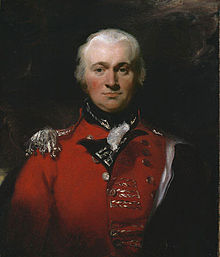Robert Brownrigg
|
General Sir Robert Brownrigg, Bt GCB |
|
|---|---|

1810 painting by Thomas Lawrence
|
|
| 3rd Governor of British Ceylon | |
|
In office 11 March 1812 – 1 February 1820 |
|
| Preceded by |
John Wilson acting governor |
| Succeeded by |
Edward Barnes acting governor |
| 10th General Officer Commanding, Ceylon | |
|
In office 1812–1812 |
|
| Preceded by | John Wilson |
| Succeeded by | Alexander Cosby Jackson |
| Personal details | |
| Born | 1759 County Wicklow, Ireland |
| Died | 27 April 1833 (aged 73–74) Monmouth, Monmouthshire, Wales |
| Awards | Knight Grand Cross of the Order of the Bath |
| Military service | |
| Allegiance | United Kingdom |
| Service/branch | British Army |
| Rank | General |
| Commands | General Officer Commanding, Ceylon |
General Sir Robert Brownrigg, 1st Baronet, GCB (1759 – 27 April 1833) was a British statesman and soldier. Brownrigg brought the last part of Sri Lanka under British rule.
Brownrigg was commissioned as an ensign in 1775. After service with the 9th (East Norfolk) Regiment of Foot, he was appointed Military Secretary to the Duke of York in 1795, and accompanied him to The Helder in Holland in 1799.
In 1803 he was appointed Quartermaster-General to the Forces. In 1805 he was made Colonel of the 9th (East Norfolk) Regiment and in July 1809, he joined the expedition to the Schelt.
He left his post as Quartermaster-General to the Forces in 1811. Then, in 1813, he was appointed Governor of Ceylon. In 1815, he acquired the Kingdom of Kandy through an agreement with the help of defecting ministers of the Kandyan King, in the central region of the island, and annexed it to the British crown. The treaty was historically known as "Kandyan Convention". In recognition of his achievement, Brownrigg was created a baronet in 1816. T
Brownrigg fought the Great Rebellion of 1817–18 and managed to defeat that, aided by reinforcements from India.
He attained the rank of full General in 1819 and left Ceylon the following year.
The gilded bronze ancient Statue of Tara was reputedly found on the eastern coast of Sri Lanka. It was acquired by Brownrigg, who later donated it to the British Museum when he was living near Monmouth in 1830. This account however is rejected by the authorities in Sri Lanka who believe that Brownrigg took the statue from the last King of Kandy when the British annexed Kandy.
...
Wikipedia
